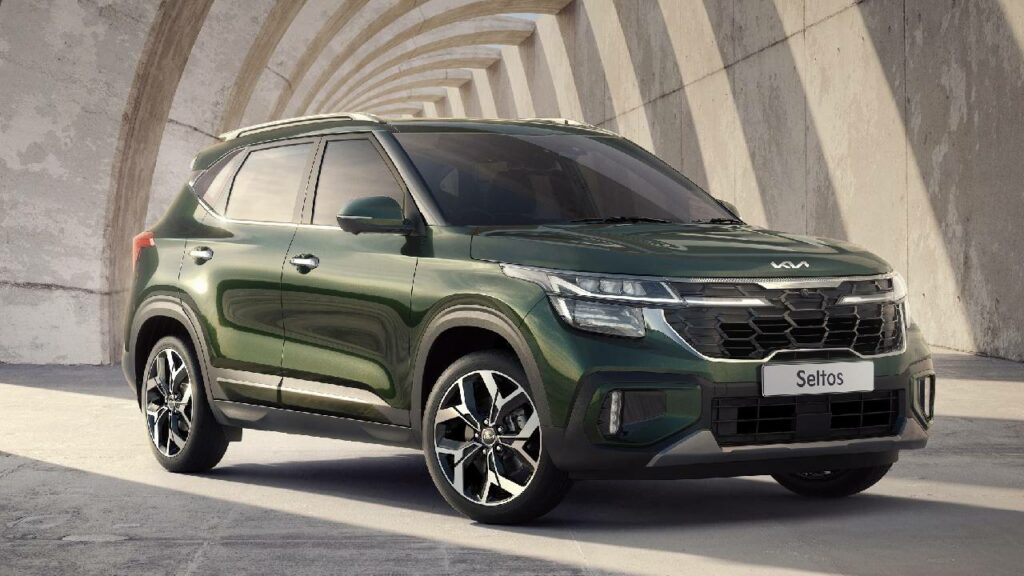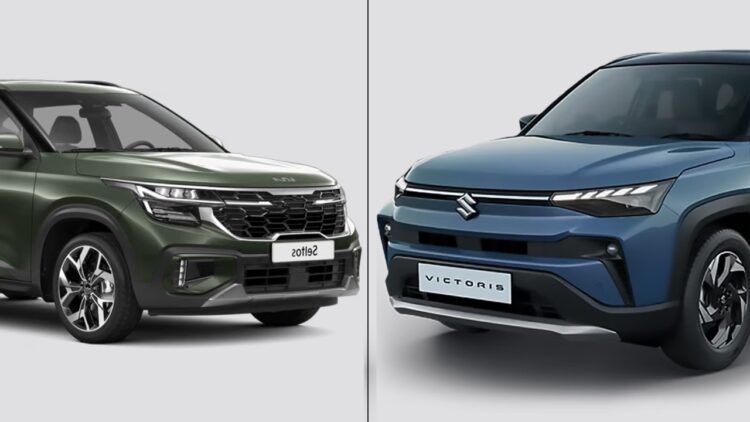Maruti has added yet another weapon in its arsenal to challenge the dominance of the Korean car makers in the mid-size SUV segment
In this post, we compare the new Maruti Victoris and the Kia Seltos on the basis of specs, features, design and dimensions. The largest carmaker in the country has diversified its lineup with a second mid-size SUV after the existing Grand Vitara. However, the Victoris will be sold via the Arena dealerships, which are over 3,000 in number, stretched across the width of the nation. Hence, it will get much more exposure than the Grand Vitara, which is sold through Nexa dealerships. On the other hand, the Kia Seltos is one of the most successful mid-size SUVs in the country. Its design, features, multiple powertrain options, etc., are some of the main reasons for its massive demand. For now, let us compare the two thoroughly.
Maruti Victoris vs Kia Seltos – Features
Let us begin this section by looking at the kind of tech, connectivity, convenience and safety amenities on offer on these vehicles. Since Victoris is the new SUV in our market, we shall commence with it. Among many new-age tech functionalities, the most impressive aspect during the unveiling event was the fact that it is a 5-star safety-rated SUV at Bharat NCAP. That is something which we really appreciate. We know that it has become a critical parameter for most carmakers before making a purchase decision. The other highlights include:
- 10.25-inch Digital Driver’s Instrument Cluster
- 10.1-inch HD Touchscreen Infotainment Display
- 8-way Powered Driver’s Seat
- Ventilated Front Seats
- Wireless Charging with Active Cooling
- Adjustable Headrests (All Seats)
- 35+ Apps
- OTA Updates
- Remote Functions
- Leatherette Steering Wheel
- New-gen Suzuki Connect with 60+ Features
- 60 Watt Charging Dock
- Smart-powered Tailgate with Gesture Control
- Customized 64-colour Ambient Lighting
- Level 2 ADAS
- Autonomous Braking System
- Adaptive Cruise Control
- Blind Spot Monitoring
- 6 Airbags as Standard
- Front and Rear Parking Sensors
- Tyre Pressure Monitoring System
- ISOFIX Child Seat Mounts
- Tyre Repair Kit
- All Seats Belts with 3-point Connection
- Day & Night Adjustable IRVM
- 360-degree Camera
- Intelligent Navigation
- Alexa Voice Command
- Underbody CNG Kit (maximizing boot space)
- Panoramic Sunroof
- PM2.5 Air Purifier
- 8-speaker Premium Infinity Surround Sound System by Harman with Dolby Atmos
- In built 8-Channel Amplifier with 5.1 Surround Sound
- Textured Dashboard with Soft Touch Materials
- Personalization Options
- Head-up Display
- 10 Colours
- Silver Metallic Finish Accent Around AC Vents
On the other hand, the Kia Seltos is arguably the most feature-laden vehicle in its class. In fact, that has been its major attraction since inception. Its top attractions are:
- Two 10.25-inch Panoramic Dual Displays for Infotainment and Driver’s Instrument Cluster
- 19 autonomous ADAS Level 2 Features
- Voice-controlled Dual-Pane Panoramic Sunroof
- Wireless Apple CarPlay and Android Auto
- 34 Safety features
- Kia Connect Connected Car Tech
- Alexa Home-to-Car Connectivity
- Ventilated Front Seats with 8-way Powered Adjustment
- Smart Air Purifier with Virus and Bacteria Protection
- 8-Speaker Premium Bose Sound System
- Dual-Zone Fully Automatic Air Conditioner
- OTA Map and System Update
- Voice-Controlled Window Function
- Remote AC Control
- 6 Airbags
- 360-degree Blind Spot Monitoring Camera
- Electronic Stability Control (ESC)
- Hill Start Assist (HSA)
- Vehicle Stability Management (VSM)
- All-Four Disc Brakes
- Ambient Lighting
- Paddle Shifters
- Electric Parking Brake with Auto Hold
- Smartphone Wireless Charger
- 8-inch Head-Up Display
- AI Voice Recognition System
Maruti Victoris vs Kia Seltos – Specs
The new Maruti Victoris is offered with three engine choices – a 1.5-litre 4-cylinder mild-hybrid petrol, a 1.5-litre 4-cylinder strong-hybrid petrol, and a 1.5-litre 4-cylinder Bi-fuel (petrol + CNG). These produce 103 PS / 139 Nm, 116 PS / 141 Nm, and 87 PS / 121 Nm of power and torque, respectively. The mild-hybrid engine can be paired with either a 5-speed manual or a 6-speed automatic gearbox. The CNG option comes only with a 5-speed manual, while the strong hybrid is linked exclusively to an e-CVT automatic unit. For light off-road driving, the mild-hybrid variant also offers the ALLGRIP SELECT AWD setup. In this version, drivers can pick from different terrain modes such as Snow, Sport, Lock, and Auto. The mileage figures are 21.18 km/l (MT), 21.06 km/l (AT), 19.07 km/l (AWD), 27.02 km/kg (CNG) and 28.65 km/l (Strong Hybrid).
On the other hand, even the Kia Selto comes with multiple powertrain options, including a diesel engine, which is missing in the Victoris. These include a 1.5-litre petrol unit producing 115 PS and 144 Nm, a 1.5-litre diesel engine delivering 115 PS and 250 Nm, and the most powerful motor in this class – a 1.5-litre turbo petrol that makes 160 PS and 253 Nm of peak output. These engines are offered with manual, automatic, CVT, and DCT transmissions. This ensures that the needs of all kinds of buyers are met. Its diesel mill can definitely provide a huge advantage over the Victoris for some buyers.
| Specs | Maruti Victoris | Kia Seltos |
| Engine | 1.5L Mild Hybrid Petrol / 1.5L Strong Hybrid / 1.5L CNG | 1.5L (P) / 1.5L (D) 1.5L (Turbo P) |
| Power | 103 PS / 116 PS / 87 PS | 115 PS / 116 PS / 160 PS |
| Torque | 139 Nm / 141 Nm / 121 Nm | 144 Nm / 250 Nm / 253 Nm |
| Transmission | 5MT / 6AT / e-CVT | MT / AT / CVT / DCT |
| Mileage | 21.18 km/l (MT), 21.06 km/l (AT), 19.07 km/l (AWD), 27.02 km/kg (CNG) and 28.65 km/l (Strong Hybrid) | – |
Design and Dimensions Comparison
Now, let’s look at the styling offered on these SUVs. While both belong to the same category, each one carries its own unique design. The new Maruti Victoris brings a modern look aimed at today’s customers. At the front, it has sleek LED DRLs connected by a chrome strip with the Suzuki logo in the centre. Just below sit the LED headlamps, and the lower part has a rugged bumper with a skid plate. On the sides, the standout detail is the squared wheel arches with black cladding that surround the dual-tone alloy wheels. Other elements include roof rails, blacked-out pillars, and a distinct rear overhang. At the rear, it offers connected LED tail lamps, a shark-fin antenna, a roof spoiler, and a sporty bumper with a sturdy skid plate. Overall, the SUV carries a strong road presence, something buyers in India admire the most.
On the other side, the Kia Seltos shows a strong road presence with plenty of modern styling bits. At the front, it features the signature Tiger Nose grille with chrome touches, sleek LED headlamps with integrated DRLs, vertical fog lamps on the bumper corners, and a solid skid plate below. From the side, the stylish alloy wheels stand out, placed inside matte black wheel arches, while the side cladding gives a rugged feel. Roof rails and blacked-out pillars further enhance the premium look. At the back, there is a shark fin antenna, connected LED tail lamps joined by a light strip, and a sporty bumper with a silver skid plate for extra toughness. Overall, both these SUVs deliver an eye-catching design.
| Dimensions (in mm) | Maruti Victoris | Kia Seltos |
| Length | 4,360 | 4,365 |
| Width | 1,795 | 1,800 |
| Height | 1,655 | 1,620 |
| Wheelbase | 2,600 | 2,610 |

My View
This is a mighty interesting comparison. Both these vehicles offer distinct amenities to entice new car buyers. However, because the prices of the new Maruti Victoris have not been announced yet, it will be slightly difficult to reach a conclusion. In any case, both these are capable and appealing products with concrete attractions to catch the interest of customers. If you want a diesel SUV with all the bells and whistles, the Kia Seltos will have to be your choice. However, if you wish to go on occasional off-road excursions or want high mileage, the strong hybrid iteration of the Maruti Victoris will make a lot of sense. Therefore, your personal requirements should drive your decision.
Also Read: New Maruti Victoris Launched in India – All You Need To Know!


